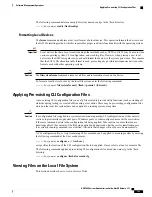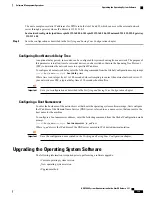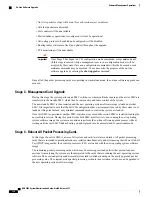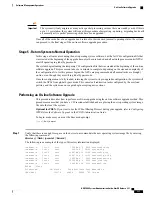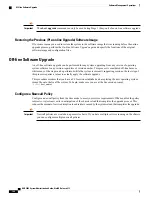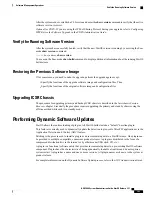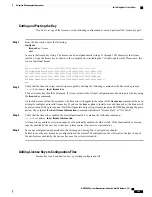
The system will only migrate as many active packet processing cards as there are standby cards. If this is
not a 1:1 correlation, the system will repeat this procedure of migrating - updating - migrating back until
all normally active packet processing cards have been upgraded.
Important
Once all of the cards have been upgraded and returned to their desired (normal) operating states, the system
can proceed to the final stage of the on-line software upgrade procedure.
Stage 5 - Return System to Normal Operation
In this stage, all cards are running the new operating system software, but the full CLI configuration file that
was created at the beginning of the upgrade has not yet been re-loaded and all network processor units (NPUs)
are still operating in global bypass mode.
The system begins loading the temporary CLI configuration file that was created at the beginning of the on-line
software upgrade. This process can take over a minute to complete, depending on the size and complexity of
the configuration file. As this process begins, the NPUs are programmed and all normal tasks are brought
on-line, even though they are still in global bypass mode.
Once the configuration is fully loaded, returning the system to its pre-upgrade configuration, the system will
switch the NPUs from global bypass mode. This cancels all redirection tasks configured by the overload
policies, and the system can once again begin accepting new sessions.
Performing an On-line Software Upgrade
This procedure describes how to perform a software upgrade using the on-line software upgrade method. This
procedure assumes that you have a CLI session established and are placing the new operating system image
file onto the local file system.
Optional for PDSN
: If you want to use the IP Pool Sharing Protocol during your upgrade, refer to
Configuring
IPSP Before the Software Upgrade
in the
PDSN Administration Guide
.
To begin, make sure you are at the Exec mode prompt.
[local]
host_name
#
Step 1
Verify that there is enough free space on the device to accommodate the new operating system image file by entering
the following command:
directory { /flash | /pcmcia1 | /hd-raid }
The following is an example of the type of directory information displayed:
-rwxrwxr-x
1 root
root
7334 May
5
2012 startconfig.cfg
-rwxrwxr-x
1 root
root
399 Jun
7 18:32 system.cfg
-rwxrwxr-x
1 root
root
10667 May 14 16:24 testconfig.cfg
-rwxrwxr-x
1 root
root
10667 Jun
1 11:21 testconfig_4.cfg
-rwxrwxr-x
1 root
root
5926 Apr
7
2012 tworpcontext.cfg
-rwxrwxr-x
1 root
root
15534 Aug
4
2012 test_vlan.cfg
-rwxrwxr-x
1 root
root
2482 Nov 18
2011 gateway2.cfg
94844
/flash
Filesystem
1k-blocks
Used Available Use% Mounted on
/dev/hda1
124778
94828
29950
76% /flash
ASR 5000 System Administration Guide, StarOS Release 21.1
137
Software Management Operations
On-Line Software Upgrade
Summary of Contents for ASR 5000
Page 26: ...ASR 5000 System Administration Guide StarOS Release 21 1 xxvi Contents ...
Page 316: ...ASR 5000 System Administration Guide StarOS Release 21 1 288 VLANs VLAN Related CLI Commands ...
Page 400: ...ASR 5000 System Administration Guide StarOS Release 21 1 372 Engineering Rules ECMP Groups ...

